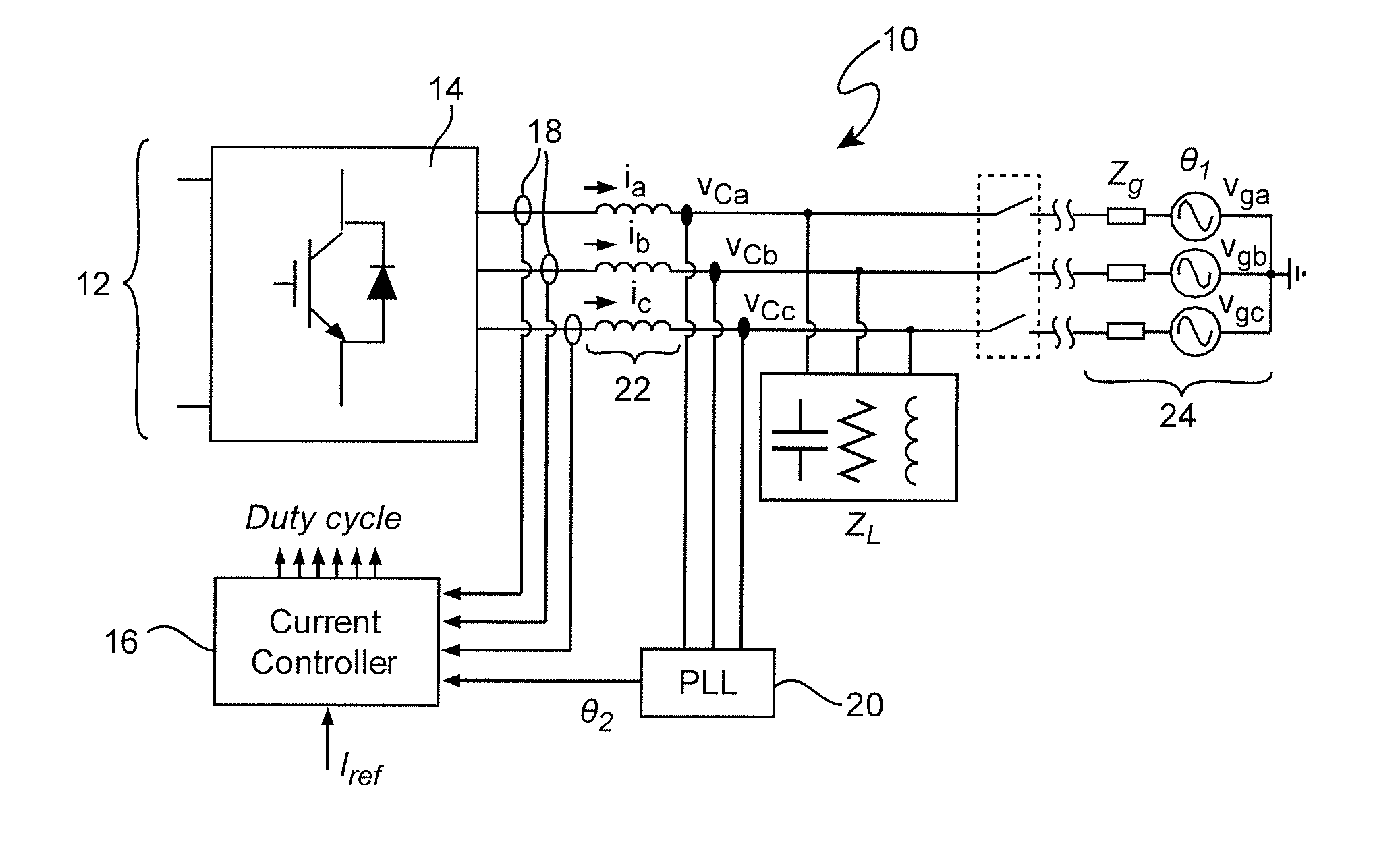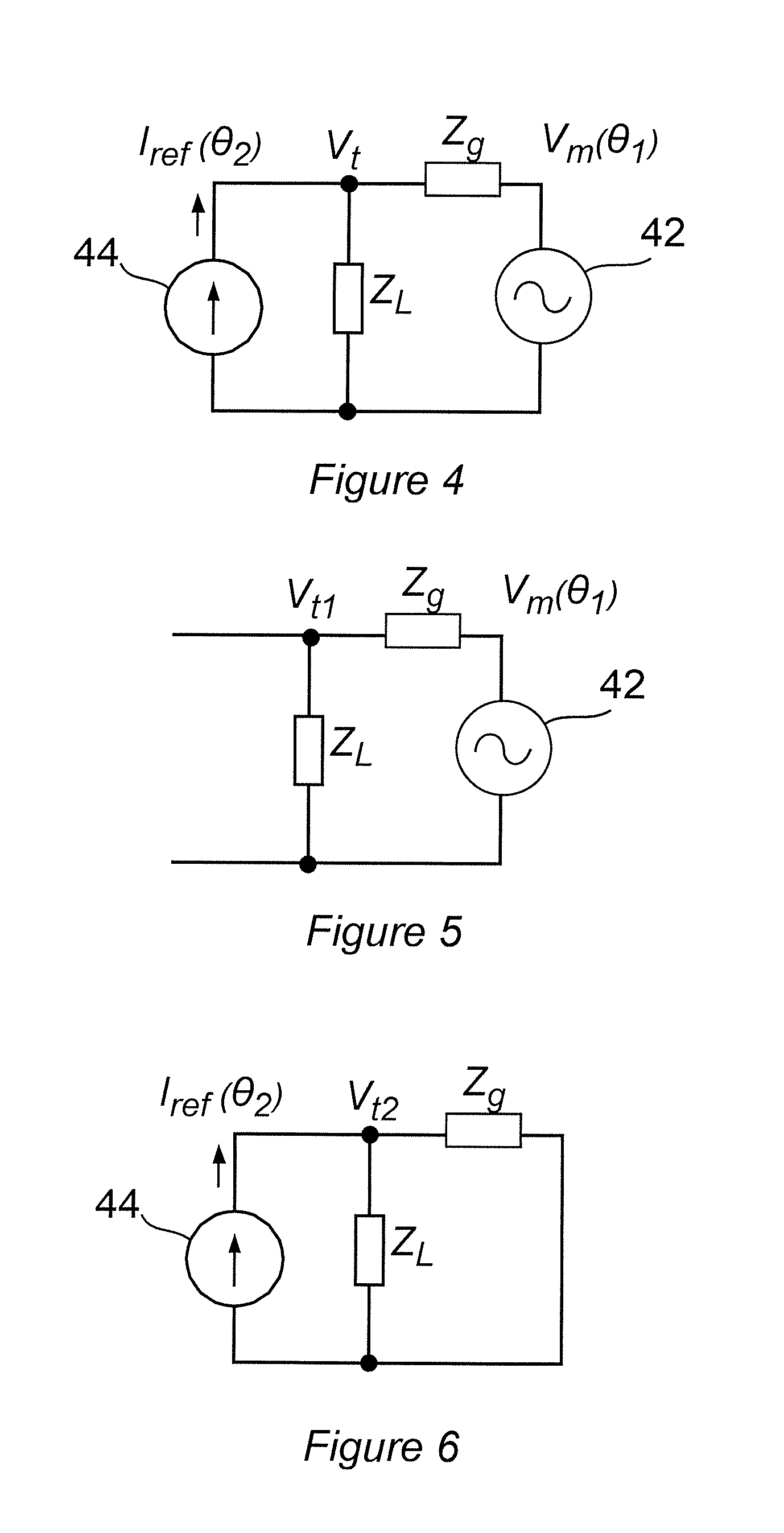[0049]To better understand this function which supports an important meritorious effect of the invention, reference is now made to FIGS. 10-12 and a comparison of FIGS. 9 and 10 to FIGS. 7 and 8 may be helpful, as well. Specifically, the PLL of FIG. 9 can be modeled as illustrated in FIG. 10 in which the upper, negative and lower,
positive feedback loops, as discussed above in connection with FIG. 8 are evident. The notation sin( ) shown in the control block represents the sine function” if the input and output of the control block are x and y, respectively, then the relationship is y=sin x. As noted above, when the PLL is grid-connected, the upper,
negative feedback loop is dominant (since k is small compared to θ1 and p1) and the depiction of FIG. 10 reduces to the model illustrated in FIG. 11 which accurately tracks the phase information from the grid. Conversely, in the islanded condition, upper,
negative feedback loop effectively vanishes and the converter frequency varies with k (e.g. p2−k); following the variation of the input injection signal.
[0050]The response of the PLL of FIG. 10 under grid connected and islanded conditions is illustrated in FIG. 13 illustrating PLL frequency as a function of time. If only considering the proportional
gain Kp in the PLL, but not the effect of the
triangular wave, the output frequency will be constant at 2π60 rad / sec as shown at 132. If considering only the effects of Kp and the triangular waveform (also sometimes referred to simply as k in reference to the gain shown in FIG. 9) the frequency will vary with k but will not drift over time; returning to 2π60 when the triangular waveform returns to zero as shown at 134. A larger k will cause more frequency variation and a more sharply angled frequency waveform. If both Kp and
integrator Ki are considered, Ki will allow the varying frequency to drift downward as shown at 136. This frequency variation and drift are effectively a perturbation which will cause the lower,
positive feedback loop to drive the converter frequency away from 2π60 unconditionally and within a very short period after islanding occurs. In FIG. 13, the change in K2 and p2 in terms of w2 are not considered since they are generally very small within the first two seconds or cycles of k, especially if the quality factor, Q=R*sqrt(C / L), of the resonant load is very small. If Q is large, the effect of K2 and p2 can be calculated.
[0051]It is important to note that the period of the variation of k in FIG. 13 is about 1.0 seconds or less, as is preferred. Under such conditions at least one peak in the frequency will occur within two seconds of an islanding event; the
time limit specified in the IEEE standard. Thus the frequency of the PLL output can be monitored and islanding can be reliably detected based on either of two conditions illustrated in FIG. 14. Specifically, when k reaches a maximum, kmax, the frequency can be compared with 60 Hz and, if the difference is above a threshold, islanding can be determined to have occurred. Similarly, when k reaches kmax, the frequency can be compared with the frequency when k=0 and if the difference is greater than a threshold (e.g. the frequency variation due to variation in k plus a small tolerance) islanding can also be determined to have occurred.
[0052]
Simulation result for a load of 10Ω+600 μf+11.5 mH is shown in FIG. 15 which indicates that the output frequency of the PLL will follow a small signal k having a
peak value of only 200μ (since this is a gain of a
control signal, there are no physical units) and thus the islanding condition can be easily detected with only a negligible effect on the PLL when grid connected. The experimental results shown in FIG. 16 agree well with the
simulation results with the same / / RCL load resonant at 60 Hz.
[0053]The islanding detection technique, PLL and
algorithm of the first embodiment can be shown to not violate the LVRT requirements of the IEEE standard. That is,
low voltage grid conditions should not be detected as an islanding event. The test circuit for determining if this condition is met is illustrated in FIG. 17, as specified in the IEEE standard. Essentially, this test circuit inserts a switched small
shunt impedance, Z2 to simulate the
low voltage condition. The corresponding one-line
equivalent circuit diagram is illustrated in FIG. 18. Based on the
equivalent circuit of FIG. 18, the parameters of the generic PLL model are given by the equations:{K1=Zs / / ZLZs / / ZL+ZgK2=(Zs / / ZL)ZgZs / / ZL+Zg(9){p1=phase[Zs / / ZLZs / / ZL+Zg]p2=phase[(Zs / / ZL)ZgZs / / ZL+Zg](10)
[0054]Thus it is seen from equation 10 that the ratio of K1 and K2 does not change under the
low voltage condition and there is only a small change in the phase shift term p2. Therefore, if the grid is a reasonably stiff grid with Zg near zero, low
voltage conditions will not be detected as an islanding condition or event. A
simulation of low
voltage conditions is graphically illustrated in FIG. 19 with Zg and Zs, shown in FIG. 18 chosen to be 0.56 p.u. (a relatively large value) and 0.056 per unit (p.u.) impedance, only the relative value being important in regard to a power
system representing a vary weak grid; a substantially worst case. FIG. 19 shows that the PLL is stable during the low
voltage period.
 Login to View More
Login to View More  Login to View More
Login to View More 


